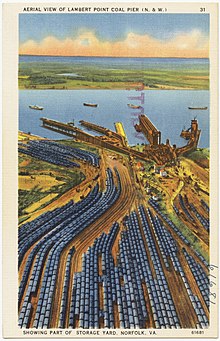
Victoria is an incorporated town in Lunenburg County, Virginia, United States. The population was 1,725 at the 2010 census, which was down from the 1,821 reported in 2000.
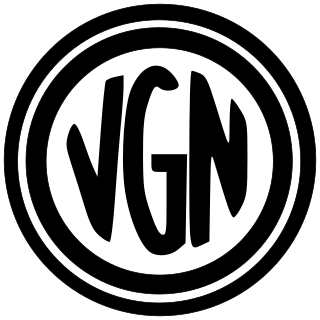
The Virginian Railway was a Class I railroad located in Virginia and West Virginia in the United States. The VGN was created to transport high quality "smokeless" bituminous coal from southern West Virginia to port at Hampton Roads.

William Nelson Page was an American civil engineer and industrialist. He was active in the Virginias following the U.S. Civil War. Page was widely known as a metallurgical expert by other industry leaders and investors as well as state and federal authorities.
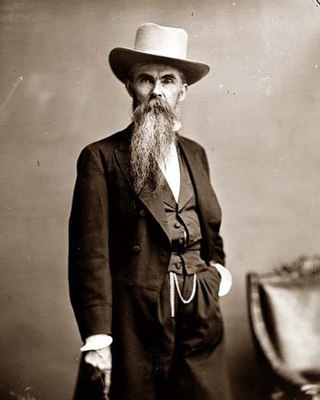
William Mahone was an Confederate States Army General, civil engineer, railroad executive, prominent Virginia Readjuster and ardent supporter of former slaves.

Frederick James Kimball was a civil engineer. He was an early president of the Norfolk and Western Railway and helped develop the Pocahontas coalfields in Virginia and West Virginia.

Otelia Butler Mahone from Smithfield, Virginia was a nurse during the American Civil War and the wife of Confederate Major General William Mahone, who was a civil engineer, teacher, railroad builder, and Senator in the United States Congress. Popularly known in Virginia as the "Hero of the Battle of the Crater" during and after the Civil War, her small-of-stature husband was nicknamed "Little Billy." An illustrious "character" in her own right, strong-willed Otelia Butler Mahone became almost as well known as her famous husband. She is credited by local legend with the naming of the towns of Windsor, Ivor, Wakefield, Waverly and Disputanta along the famous 52-mile tangent railroad tracks engineered and built by her husband between the cities of Suffolk and Petersburg. When he led the formation of the Atlantic, Mississippi and Ohio Railroad (AM&O) from three trunk lines across the southern tier of Virginia in 1870, wags claimed the initials stood for "All Mine and Otelia's."
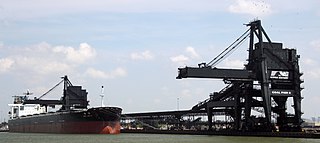
Lambert's Point is a point of land on the east shore of the Elizabeth River near the downtown area of the independent city of Norfolk in the South Hampton Roads region of eastern Virginia, United States. It includes a large coal exporting facility and a residential area. The area is south of Old Dominion University.

The Norfolk and Petersburg Railroad was built between Norfolk and Petersburg, Virginia and was completed by 1858. The line was 85 miles (137 km) of 5 ft track gauge.
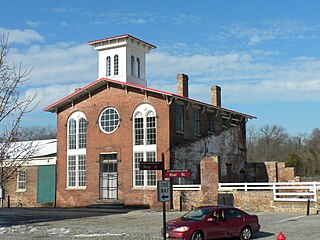
The Southside Railroad was formed in Virginia in 1846. Construction was begun in 1849 and completed in 1854. The 5 ft gauge railroad connected City Point, a port on the James River with the farm country south and west of Petersburg, Virginia, to Lynchburg, Virginia, a distance of about 132 miles (212 km).
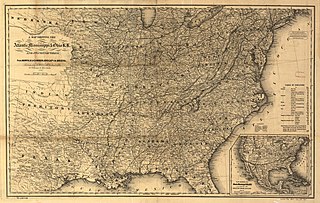
Atlantic, Mississippi and Ohio Railroad (AM&O) was formed in 1870 in Virginia from three east–west railroads which traversed across the southern portion of the state. Organized and led by former Confederate general William Mahone (1826-1895), the 428-mile (689 km) line linked Norfolk with Bristol, Virginia by way of Suffolk, Petersburg, Lynchburg, and Salem. The AM&O was promoted as a trade link to the west, and further expansion was envisioned with the goal of increasing Virginia's Ohio Valley and Mississippi Valley commerce. It was heavily backed by investors from England and Scotland.
Harold A. Reid (1925–1992), also known by the pen name H. Reid, was an American writer, photographer, and historian. Reid's photographs of steam locomotives, captured the last days of steam motive power on America's Class I railroads, notably on the Virginian Railway, and ending with the Norfolk and Western in 1960, the last major U.S. railroad to convert from steam.
The Virginia and Tennessee Railroad was an historic 5 ft gauge railroad in the Southern United States, much of which is incorporated into the modern Norfolk Southern Railway. It played a strategic role in supplying the Confederacy during the American Civil War.
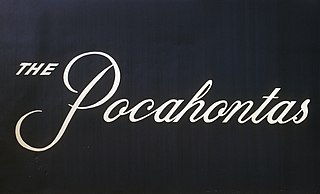
The Pocahontas was one of the named passenger trains of the Norfolk and Western Railway. It ran overnight between Norfolk, Virginia, and Cincinnati, Ohio, with a through-car to and from Chicago, Illinois. The Pocahontas ran from November 1926 until May 1971.

The Powhatan Arrow was a named luxurious passenger train, operated by the Norfolk and Western Railway (N&W) in the United States. It made its inaugural operation on April 28, 1946, and proclaimed as one of America's first new postwar streamliners, despite not having new equipment. The Powhatan Arrow had two trains; Nos. 25 and 26, which both ran 676 miles (1,088 km) daily at daylight on the N&W mainline between Norfolk, Virginia, and Cincinnati, Ohio in opposite directions. It takes about 15 hours and 45 minutes for both trains to run per day. They were hauled behind N&W's streamlined 4-8-4 class J steam locomotives.

The Norfolk and Western J class was a class of 14 4-8-4 "Northern" streamlined steam locomotives built by the Norfolk and Western Railway (N&W) at its Roanoke Shops in Roanoke, Virginia, between 1941 and 1950. The most powerful 4-8-4 locomotives ever produced, the J class were part of the N&W's "Big Three" that represented the pinnacle of steam technology.

The Virginia Museum of Transportation (VMT) is a museum in Downtown Roanoke, Virginia, that is devoted to the topic of transportation.

Norfolk and Western 2156 is a preserved Y6a class 2-8-8-2 compound Mallet steam locomotive. The Norfolk and Western Railway (N&W) built it in 1942 at its own Shops in Roanoke, Virginia as the second member of the N&W's Y6a class. No. 2156 and its class are considered to be the world's strongest-pulling extant steam locomotive to ever be built.

Norfolk and Western 611, also known as the "Spirit of Roanoke" and the "Queen of Steam", is the only surviving example of Norfolk and Western's (N&W) class J 4-8-4 type "Northern" streamlined steam locomotives. Built in May 1950 at N&W's Roanoke Shops in Roanoke, Virginia, it was one of the last mainline passenger steam locomotives built in the United States and represents one of the pinnacles of American steam locomotive technology.
The 21st Century Steam program was conducted by the Norfolk Southern Railway from 2011 to 2015, featuring four classic steam locomotives pulling passenger excursions along Norfolk Southern rails in the eastern United States. The last train was to be Southern 4501's Piedmont Limited excursion trip from Atlanta, Georgia, to Toccoa, Georgia, but cancelled on October 1 due to Hurricane Joaquin.

The Cedar train wreck occurred on the night of January 23, 1956, when the Norfolk and Western (N&W) Pocahontas passenger train derailed at more than 50 mph (80 km/h) along the Tug River near Cedar, West Virginia. The accident killed the engineer and injured 51 passengers and nine crew members. It was the last major wreck of a steam-powered revenue passenger train in the United States.




